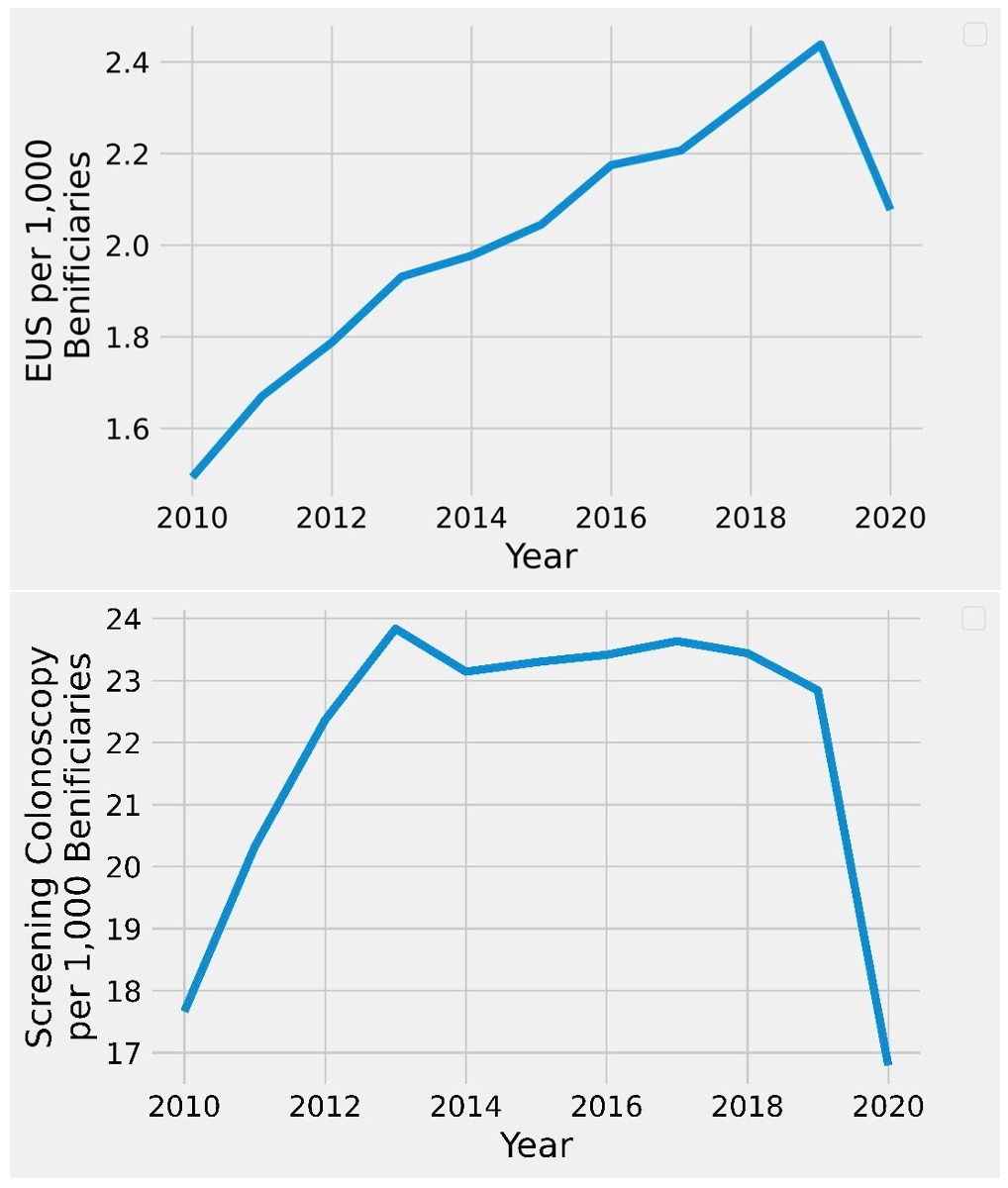Back
Poster Session D - Tuesday Morning
D0278 - Impact of COVID-19 on Outpatient EUS and Screening Colonoscopy Utilization in the Medicare Population
Tuesday, October 25, 2022
10:00 AM – 12:00 PM ET
Location: Crown Ballroom

Shaina H. Hasan, MD
University of Virginia Health System
Charlottesville, VA
Presenting Author(s)
Shaina H. Hasan, MD1, Shivram Chandramouli, MD2, Aditya Khurana, MD3, Alexander Podboy, MD4
1University of Virginia Health System, Charlottesville, VA; 2Duke University, Durham, NC; 3Mayo Clinic, Rochester, MN; 4University of Virginia, Charlottesville, VA
Introduction: With the COVID-19 pandemic, the Centers for Medicare & Medicaid Services (CMS) initially recommended all nonurgent surgical and medical procedures be delayed. We evaluated the impact of COVID-19 on endoscopic ultrasound (EUS) and screening colonoscopies in the outpatient setting in the Medicare population.
Methods: The CMS Physician/Supplier Procedure Summary (PSPS) Database displays Part B claims organized by CPT code. Codes that involved EUS [43237, 43238, 43240, 43242, 43253, 43259], and screening colonoscopies [G0105, G0121], were included. Services at the top 4 outpatient places-of-service (ambulatory surgery centers, office, and off- and on-campus outpatient hospitals) were used to evaluate outpatient volumes. The number of EUS and screening colonoscopies was normalized by the number of Original Medicare beneficiaries per year to produce number of procedures per 1,000 Medicare enrollees. The compound annual growth rates (CAGRs) as well as absolute volumes were calculated. CAGRs were calculated for two time periods: 2010-2019 and 2019-2020. A linear regression model for 2010-2019 procedure volume data estimated anticipated yearly procedure volume for 2020.
Results: The number of EUS per 1,000 Medicare enrollees increased from 1.49 in 2010 to 2.44 in 2019, for a CAGR10-19 of 5.6%. This decreased to 2.08 in 2020, for a CAGR19-20 of -14.81%.
The number of EUS increased from 48,139 in 2010 to 80,468 in 2019, for a CAGR10-19 of 5.90%. This decreased to 66,976 in 2020, for an AR of -16.95%.
The number of screening colonoscopies per 1,000 Medicare enrollees increased from 17.66 in 2010 to 22.84 in 2019, for a CAGR10-19 of 2.90%. This decreased to 16.79 in 2020, for a CAGR19-20 of -26.47%.
The number of screening colonoscopies increased from 569,372 in 2010 to 755,491 in 2019, for a CAGR10-19 of 3.19%. This decreased to 541,522 in 2020, for an AR of -28.32%.
A linear regression model for 2010-2019 procedural volume data predicted a 12-month EUS volume of 84,043 (95% CI, 83,606-84,480; multiple R2, 0.973) and a 12-month screening colonoscopy volume of 772,481 (95% CI, 758,819-786,091; multiple R2, 0.445). The total EUS and screening colonoscopy volume was significantly lower than the low range of the 95% CI (66,976 versus 83,606; 541,522 versus 758,819, p < 0.05).
Discussion: COVID-19 significantly impacted outpatient utilization of EUS and screening colonoscopies. This is concerning as missed or delayed diagnoses could directly impact the incidence of avoidable gastrointestinal malignancies.

Disclosures:
Shaina H. Hasan, MD1, Shivram Chandramouli, MD2, Aditya Khurana, MD3, Alexander Podboy, MD4. D0278 - Impact of COVID-19 on Outpatient EUS and Screening Colonoscopy Utilization in the Medicare Population, ACG 2022 Annual Scientific Meeting Abstracts. Charlotte, NC: American College of Gastroenterology.
1University of Virginia Health System, Charlottesville, VA; 2Duke University, Durham, NC; 3Mayo Clinic, Rochester, MN; 4University of Virginia, Charlottesville, VA
Introduction: With the COVID-19 pandemic, the Centers for Medicare & Medicaid Services (CMS) initially recommended all nonurgent surgical and medical procedures be delayed. We evaluated the impact of COVID-19 on endoscopic ultrasound (EUS) and screening colonoscopies in the outpatient setting in the Medicare population.
Methods: The CMS Physician/Supplier Procedure Summary (PSPS) Database displays Part B claims organized by CPT code. Codes that involved EUS [43237, 43238, 43240, 43242, 43253, 43259], and screening colonoscopies [G0105, G0121], were included. Services at the top 4 outpatient places-of-service (ambulatory surgery centers, office, and off- and on-campus outpatient hospitals) were used to evaluate outpatient volumes. The number of EUS and screening colonoscopies was normalized by the number of Original Medicare beneficiaries per year to produce number of procedures per 1,000 Medicare enrollees. The compound annual growth rates (CAGRs) as well as absolute volumes were calculated. CAGRs were calculated for two time periods: 2010-2019 and 2019-2020. A linear regression model for 2010-2019 procedure volume data estimated anticipated yearly procedure volume for 2020.
Results: The number of EUS per 1,000 Medicare enrollees increased from 1.49 in 2010 to 2.44 in 2019, for a CAGR10-19 of 5.6%. This decreased to 2.08 in 2020, for a CAGR19-20 of -14.81%.
The number of EUS increased from 48,139 in 2010 to 80,468 in 2019, for a CAGR10-19 of 5.90%. This decreased to 66,976 in 2020, for an AR of -16.95%.
The number of screening colonoscopies per 1,000 Medicare enrollees increased from 17.66 in 2010 to 22.84 in 2019, for a CAGR10-19 of 2.90%. This decreased to 16.79 in 2020, for a CAGR19-20 of -26.47%.
The number of screening colonoscopies increased from 569,372 in 2010 to 755,491 in 2019, for a CAGR10-19 of 3.19%. This decreased to 541,522 in 2020, for an AR of -28.32%.
A linear regression model for 2010-2019 procedural volume data predicted a 12-month EUS volume of 84,043 (95% CI, 83,606-84,480; multiple R2, 0.973) and a 12-month screening colonoscopy volume of 772,481 (95% CI, 758,819-786,091; multiple R2, 0.445). The total EUS and screening colonoscopy volume was significantly lower than the low range of the 95% CI (66,976 versus 83,606; 541,522 versus 758,819, p < 0.05).
Discussion: COVID-19 significantly impacted outpatient utilization of EUS and screening colonoscopies. This is concerning as missed or delayed diagnoses could directly impact the incidence of avoidable gastrointestinal malignancies.

Figure: Trends in EUS and screening colonoscopies per 1,000 Medicare Beneficiaries from 2010-2020
Disclosures:
Shaina Hasan indicated no relevant financial relationships.
Shivram Chandramouli indicated no relevant financial relationships.
Aditya Khurana indicated no relevant financial relationships.
Alexander Podboy indicated no relevant financial relationships.
Shaina H. Hasan, MD1, Shivram Chandramouli, MD2, Aditya Khurana, MD3, Alexander Podboy, MD4. D0278 - Impact of COVID-19 on Outpatient EUS and Screening Colonoscopy Utilization in the Medicare Population, ACG 2022 Annual Scientific Meeting Abstracts. Charlotte, NC: American College of Gastroenterology.

